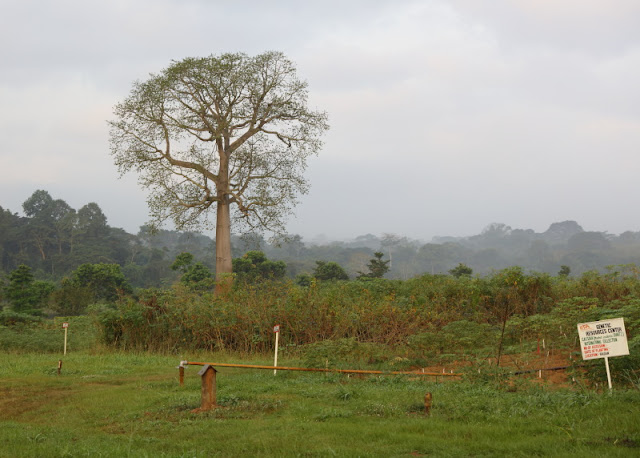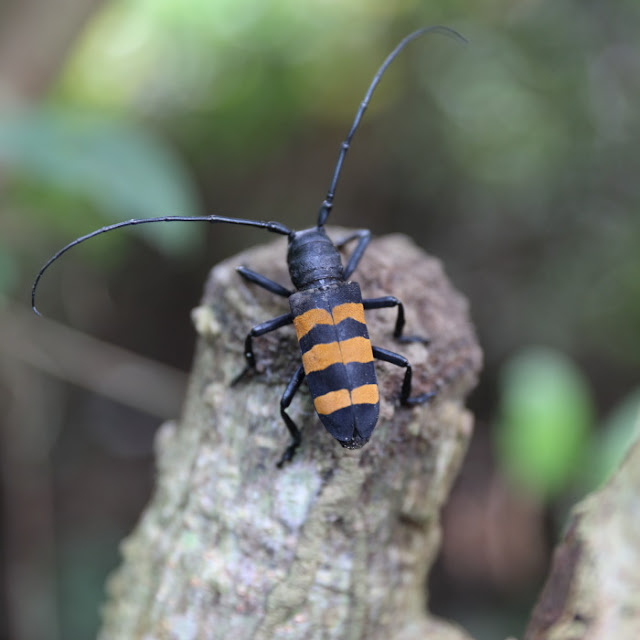 |
| forest and crops at the heart of Ibadan |
The goal of IITA is to study how to improve crops of cassava, yam, maize and plantain by selecting the varieties that are pest-resistant but also generating higher yields.
 |
| Peter Kulakow showing garri and fermenting cassava |
Cassava in West Africa is often victim of the mosaic virus which affects the leaves of the plant and therefore the ability of its tubers to grow. Peter’s team is working on selecting varieties of plants which are able to resist to this disease but also to drought while providing higher yields in starch (currently yields are fairly low, around 5 tons of cassava tubers per hectares, which could, as per Peter, easily be improved to 10 or 20 tons by using new varieties). Currently IITA performs DNA analysis to understand which genes are associated with various qualities however it is not involved with genetically modified crops.
Farmers are using cassava tubers for its starch content. Traditionally, cassava is processed into garri, a dry powder obtained by fermenting peeled cassava tubers and then grinding them into thin particles which are then put to dry. After that, it can be consumed either with water or milk, as a drink or porridge, or turned into swallows (called either eba or fufu, the latter one being fermented and having a more acidic taste). Peter explained that it would be best to consume the cassava boiled to preserve the most of its nutritious value, particularly the yellow varieties which contain carotene, but this is not in the habit of consumption in Nigeria.
IITA has been releasing various varieties of cassava over the years, one of the better known ones is an old variety from the seventies whose name contains the number 419 (pronounce "four one nine" in reference to the dubious schemes, run in Nigeria over the phone or internet to steal money from naïve people, and which have become brand ambassadors for Nigeria's toxic reputation abroad). This highlights the issue of propagation of new varieties among farmers who are rarely have the money to buy new plants or seeds. They use a property of the stem of the cassava which allows to grow a new plant out of a small chunk of the stem planted in the ground.
 |
| IITA's burgeoning neighbours |
 |
| Deni Brown, talking about forest conservation |
The forest is hosting a lot of insects and snakes (various species of cobras, the green mamba; pythons in the Awba swamp), pangolins, mangoose, grass cutters, small antilopes, monitor lizards. Deni pointed to an old yam which does not look like much above the ground but has developed a huge tuber which is apparently a delicacy for elephants who dig it with their tusks. They would also remember where it is located and come back for it a few years later once it has regrown. Deni said elephants had been there in the distant past as evidenced by the presence of a tree whose seeds only grow when they have been digested by an elephant and end-up cosily on the ground buried in elephant dung. She showed us the tree which is the basis for feeding the African silk moth. Back in the days, African silk was woven by specialized craftmen and used to produce clothes for dignitaries. Nowadays the production is sadly extinct.
The forest also features the largest flower on earth, it sits on the ground and has a dark red colour and an unpleasant smell which excites the appetite of insects who will dive into its use trump and be hold there by the plant until they are covered by its pollen so that they can carry it to the next flower. We did not see the flower because it grows between March and May.
 |
| the longhorn beetle |
 |
| the main lake at sunrise |
Comments
Post a Comment